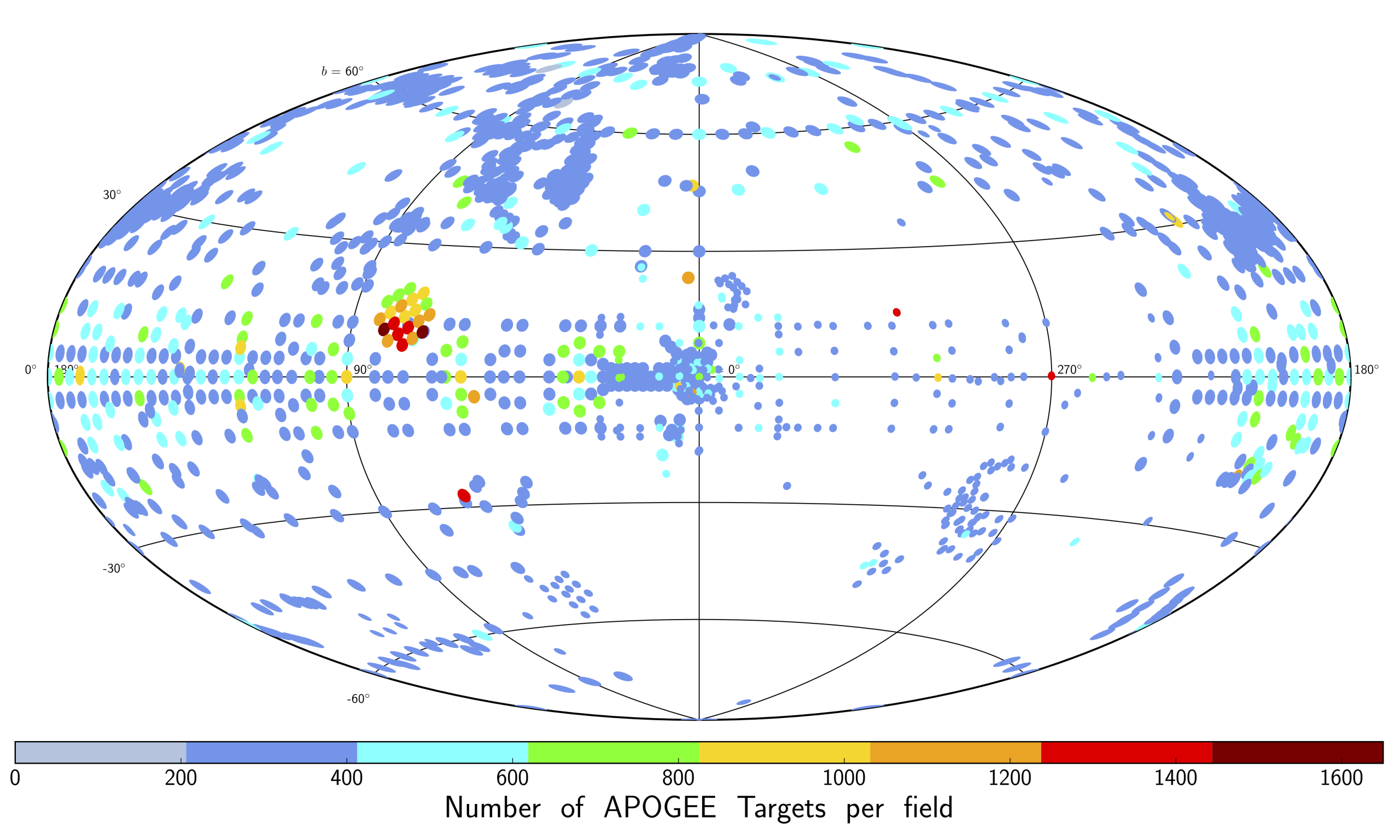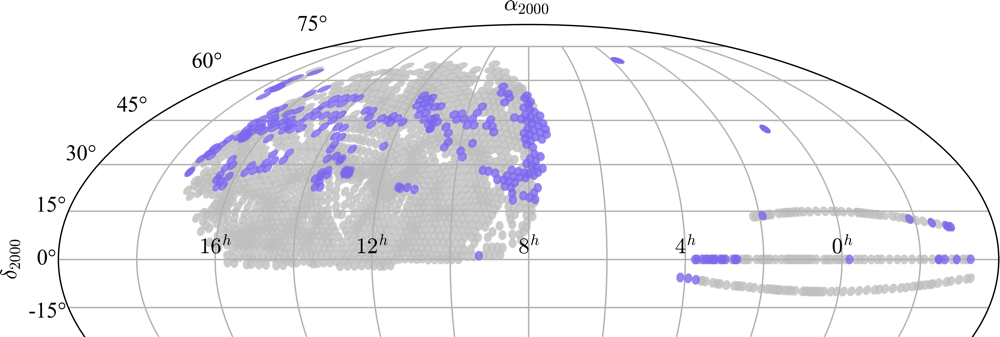DR16 Scope
Overview
Data Release 16 is the fourth data release of the fourth phase of the Sloan Digital Sky Survey. It includes SDSS data taken through August 2018, and encompasses more than one-third of the entire celestial sphere. The coverage figures below show the sky coverage of DR16 for the eBOSS, APOGEE, and MaNGA surveys respectively (click figure to enlarge).
With so much sky being mapped in so many different ways, questions about the size of the SDSS can be answered in many different ways. This page details the SDSS survey area and provides various ways to count the data of Data Release 16.
Imaging statistics
- Total unique area covered
- 14,555 square degrees
- Total area of imaging (including overlaps)
- 31,637 square degrees (excluding supernova runs)
- Individual image field size
- 1361x2048 pixels (0.0337 square degrees)
- Number of individual fields
- 938,046 (excluding supernova runs)
- Number of catalog objects
- 1,231,051,050
- Number of unique detections
- 932,891,133
- Median PSF FWHM, r-band
- 1.3 arcsec
- Pixel scale
- 0.396 arcsec
- Exposure time per band
- 53.9 sec
- Time difference between observations of each band
- 71.72 sec (in riuzg order)
- Global astrometric precision
- 0.1 arcsec rms (absolute)
- Total
- 469,053,874
- Stars
- 260,562,744
- Galaxies
- 208,478,448
- Unknown
- 12,682
(95% completeness for point sources)
- u
- 3551Å
22.0 - g
- 4686Å
22.2 - r
- 6165Å
22.2 - i
- 7481Å
21.3 - z
- 8931Å
20.5
- u
- 1.3%
- g
- 0.8%
- r
- 0.8%
- i
- 0.7%
- z
- 0.8%
All programs combined
- Total spectra
- 5,789,200
- Useful spectra
- 4,846,156
- Galaxies
- 2,863,635
- Quasars
- 960,678
- Stars
- 1,021,843
- Sky
- 475,531
- Standards
- 108,603
- Unknown
- 352,320
- Effective area (deg2)
- 1,317
- Plates
- 229
- Total spectra
- 155,520
- Unique objects
- 138,099
- Targets
- 11,040
| Statistic | Total | Unique |
|---|---|---|
| Spectroscopic effective area (deg2) | ... | 9,376 |
| Plates | 3,946 | 3,803 |
| Spectra | 3,946,000 | 3,518,265 |
| All Galaxies | 1,913,705 | 1,775,300 |
| CMASS | 980,922 | 904,686 |
| LOWZ | 374,913 | 349,071 |
| eBOSS LRG | 298,762 | 279,304 |
| eBOSS ELG | 269,889 | 252,308 |
| All Quasars | 1,032,126 | 919,221 |
| BOSS | 447,204 | 386,728 |
| eBOSS | 584,922 | 532,493 |
| Stars | 428,828 | 385,800 |
| Standard stars | 83,345 | 65,247 |
| Sky | 365,243 | 330,731 |
| Unclassified spectra | 410,338 | 361,383 |
- Total galaxies
- 4688
- Unique galaxies
- 4621
- Plate scale
- 7 deg2
- IFUs per plate
- 17
- Wavelength
- 3600-10,000 Å
- Total high-quality spectra
- 8646
- Unique stars
- 3321
- Plate scale
- 7 deg2
- IFUs per plate
- 17
- Wavelength
- 3600-10,000 Å
DR16 contains data for approximately 430,000 unique APOGEE targets in 1442 fields, of which roughly 300,000 are main survey targets. A total of 1,800,000 individual visits are included in DR16. A general breakdown of targets in DR16-associated programs follows below:
- ~34,000 stars
- in Bulge fields
- ~57,600 stars
- in Halo and Halo Stream fields
- ~89,000 stars
- co-observed on MaNGA plates
- ~128,000 stars
- in Disk fields
- ~11,200 stars
- in Satellite Galaxies fields
- ~28,000 stars
- in Young Cluster fields
- ~72,000 stars
- for Photometric Objects of Interest (POIs) in the Kepler, K2, CoRoT, and TESS footprints
- ~13,300 objects
- in Ancillary Science fields
- ~35,000 objects
- in External Program fields
- ~1000 bright stars
- observed with the NMSU 1m telescope + APOGEE, including bright standards





